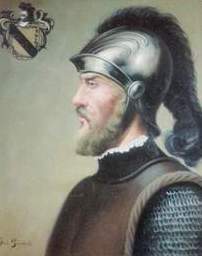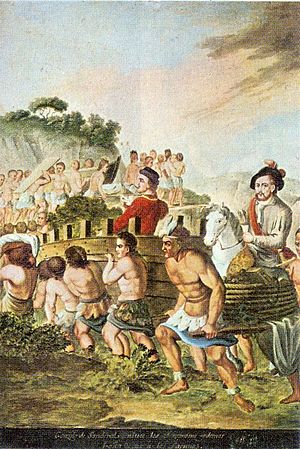Gonzalo de Sandoval facts for kids
Quick facts for kids
Gonzalo de Sandoval
|
|
|---|---|

Gonzalo de Sandoval in a contemporaneous rendition
|
|
| Governor of New Spain | |
| In office 2 March 1527 – 22 August 1527 Serving with Alonso de Estrada and Luis de la Torre
|
|
| Preceded by | Marcos de Aguilar |
| Succeeded by | Alonso de Estrada Luis de la Torre |
| Personal details | |
| Born | 1497 Medellín, Castile |
| Died | 1528 (aged 30–31) Palos de la Frontera, Castile |
| Resting place | La Rábida Friary |
| Signature |  |
Gonzalo de Sandoval (born 1497 in Medellín, Spain; died late 1528 in Palos de la Frontera, Spain) was a Spanish conquistador. He played a key role in the Spanish conquest of what is now Mexico, known then as New Spain. He was one of Hernán Cortés's most trusted leaders. For a short time, he even helped govern the colony when Cortés was away.
Contents
Joining the Conquest of New Spain
Sandoval was the youngest of Cortés's main officers. They arrived in New Spain together in 1519. After the Spanish took control of Moctezuma, the Aztec emperor, Cortés put Sandoval in charge of Villa Rica de Vera Cruz.
Sandoval quickly showed his loyalty. He captured messengers from Pánfilo de Narváez, who was trying to take control from Cortés. Sandoval sent these prisoners to Cortés. In the battle that followed, Sandoval himself captured Narváez.
He was a brave fighter during the difficult Spanish retreat known as the Noche Triste in 1520. He also fought in the important Battle of Otumba.
Battles and the Siege of Tenochtitlan
Gonzalo de Sandoval led many attacks against the Aztecs. He commanded operations from a base called La Villa Segura de la Frontera. He also led attacks on towns like Cacatami and Xalacingo.
A big task for Sandoval was helping to build and move ships called brigantines. These ships were needed for the attack on the Aztec capital, Tenochtitlan. He went to Tlaxcala to oversee their transport over land.
During the Siege of Tenochtitlan, Sandoval led attacks on Aztec forts in Chalco and Tlamanalco. He also made sure the wood for the ships reached Texcoco safely. He fought in three battles near Huaxtepec in March 1521.
Sandoval was wounded twice during battles on the causeways leading to Tenochtitlan. He was a key commander, leading one of Cortés's four main forces. During the siege, his company eventually joined Pedro de Alvarado's forces in the Tlatelolco marketplace.
One of Sandoval's men, García Holguín, captured the Aztec leader, the Tlatoani Cuauhtémoc. Holguín and Sandoval then brought Cuauhtémoc to Cortés.
After the Fall of Tenochtitlan
After the Aztec capital fell, Sandoval continued to be important. In December 1521, he helped Cortés delay Cristóbal de Tapia, who had been sent by the Spanish Crown to replace Cortés.
Sandoval also became the godfather to a noble from Tlaxcala, Citlalpopocatzin, who was then baptized as Bartolomé.
He was sent to the Coatzacoalcos region to bring peace to areas like Huatusco, Tuxtepec, and Oaxaca. He also founded the town of Medellín near Huatusco and the port of Espíritu Santo along the Coatzacoalcos River. He helped bring Centla, Chinantla, and Tabasco under Spanish control. In Pánuco, he helped stop a rebellion by local people.
Founding of Colima
In 1522, another Spanish leader, Juan Rodríguez de Villafuerte, was defeated by indigenous people in the Valley of Tecomán. Cortés then sent Gonzalo de Sandoval to conquer this area and establish a town.
On July 25, 1523, Sandoval founded the city of Colima in its first location near the coast. He also set up its city government, which was the third oldest in New Spain. Later, in 1527, the city was moved to its current spot and renamed San Sebastián de Colima.
Time in Honduras and as Governor
In 1524, Sandoval joined Cortés on an expedition to Honduras. There, he was given the title of alguacil (a type of law enforcement officer) and received some land grants.
When he returned from Honduras, he became the justicia mayor (chief justice) of New Spain. He joined the governing council of the colony on March 2, 1527, replacing Marcos de Aguilar. He served in this important role until August 22, 1527.
Return to Spain and Death
In the fall of 1527, Gonzalo de Sandoval traveled back to Spain with Cortés. They arrived at the port of Palos in December, after a quick journey of just 41 days.
Sadly, Sandoval had become very ill during the trip. He died shortly after arriving in Spain, at around 30 or 31 years old. He was buried in the La Rábida monastery.
What People Said About Him
Bernal Díaz del Castillo, who was a friend and fought alongside Sandoval, wrote about him. Díaz del Castillo said that Sandoval was a good judge and administrator, as well as a skilled soldier.
Díaz del Castillo also described Sandoval as:
He was not highly educated, but a simple man; neither was he covetous for gold, but only for fame and to be a good, strong captain. In the wars of New Spain he always took account of the soldiers... and befriended them and helped them. He was not a man who wore rich clothes, but very plain ones.
See also
 In Spanish: Gonzalo de Sandoval para niños
In Spanish: Gonzalo de Sandoval para niños


